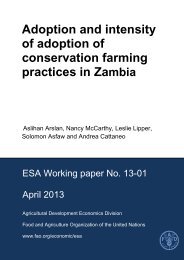Adoption and intensity of adoption of conservation farming practices in Zambia
Adoption and intensity of adoption of conservation farming practices in Zambia
Adoption and intensity of adoption of conservation farming practices in Zambia
Create successful ePaper yourself
Turn your PDF publications into a flip-book with our unique Google optimized e-Paper software.
2.3. <strong>Adoption</strong> <strong>of</strong> CF <strong>in</strong> <strong>Zambia</strong><br />
Despite its promotion over the last fifteen years, <strong>adoption</strong> <strong>of</strong> CF <strong>in</strong> <strong>Zambia</strong> is relatively<br />
limited. 7 Haggblade <strong>and</strong> Tembo (2003) report that 20% <strong>of</strong> CF farmers <strong>in</strong> the 2002/3 season<br />
were spontaneous adopters, with the 80% majority practic<strong>in</strong>g CF as a condition for receiv<strong>in</strong>g<br />
subsidised <strong>in</strong>put packages. CFU reports that around 170,000 farmers had adopted CF on part<br />
or all <strong>of</strong> their l<strong>and</strong> <strong>in</strong> 2011.<br />
<strong>Adoption</strong> tends to be <strong>in</strong>cremental <strong>and</strong> partial <strong>in</strong> <strong>Zambia</strong>. Umar et al. (2011) found that almost<br />
all farmers (out <strong>of</strong> 129 <strong>in</strong>terviewed) practice both conventional <strong>and</strong> <strong>conservation</strong> <strong>farm<strong>in</strong>g</strong> on<br />
different plots. Haggblade <strong>and</strong> Tembo (2003) reported that 0.25 ha <strong>of</strong> carefully managed<br />
bas<strong>in</strong>-plant<strong>in</strong>g CF can provide a m<strong>in</strong>imal food security safety net for a family <strong>of</strong> four.<br />
Primary constra<strong>in</strong>ts to <strong>adoption</strong> <strong>in</strong> <strong>Zambia</strong> are the use <strong>of</strong> crop residues for other purposes,<br />
labor constra<strong>in</strong>ts <strong>and</strong> the limited potential to grow cover crops dur<strong>in</strong>g the dry season. Of these<br />
three constra<strong>in</strong>ts, a number <strong>of</strong> authors argue that labor constra<strong>in</strong>t is the major constra<strong>in</strong>t to CF<br />
<strong>adoption</strong> <strong>in</strong> <strong>Zambia</strong> (Umar et al. 2011; Baudron et al. 2007; Haggblade <strong>and</strong> Tembo 2003).<br />
The labor constra<strong>in</strong>t manifests itself dur<strong>in</strong>g l<strong>and</strong> preparation <strong>and</strong> weed<strong>in</strong>g. Preparation <strong>of</strong> the<br />
plant<strong>in</strong>g bas<strong>in</strong>s is highly labor <strong>in</strong>tensive <strong>and</strong> the hir<strong>in</strong>g <strong>of</strong> labor is rarely feasible due to<br />
unaffordable daily wages at peak times (also because hir<strong>in</strong>g is not widely accepted culturally)<br />
(Baudron et al. 2007; Mazvimavi 2011). Weed<strong>in</strong>g requirements tend to be higher on CF plots<br />
(<strong>in</strong> the absence <strong>of</strong> herbicide use) creat<strong>in</strong>g another labor constra<strong>in</strong>t (Umar et al. 2011).<br />
F<strong>in</strong>d<strong>in</strong>gs related to l<strong>and</strong> <strong>and</strong> labor are supported by Chomba (2004). His study, based on<br />
nationwide post-harvest (1998/99-1999/2000) <strong>and</strong> supplemental household surveys<br />
(1999/2000) cover<strong>in</strong>g 2,524 farmers <strong>in</strong> Eastern, Southern, Central <strong>and</strong> Lusaka Prov<strong>in</strong>ces,<br />
found that household size <strong>and</strong> l<strong>and</strong> size positively <strong>in</strong>fluenced <strong>adoption</strong> rates <strong>of</strong> CF dur<strong>in</strong>g the<br />
1998-2000 seasons. He also found that distance to markets <strong>and</strong> extension services were<br />
important. This may be particularly so given that this study uses data collected early <strong>in</strong> the<br />
promotion <strong>of</strong> CF <strong>in</strong> <strong>Zambia</strong>.<br />
Nyanga et al. (2011) surveyed 469 farmers <strong>in</strong> 12 districts (<strong>in</strong> Southern, Central, Western, <strong>and</strong><br />
Eastern prov<strong>in</strong>ces) <strong>in</strong> an effort to underst<strong>and</strong> their perceptions <strong>of</strong> climate change <strong>and</strong><br />
attitud<strong>in</strong>al <strong>and</strong> knowledge-based drivers <strong>of</strong> CF <strong>adoption</strong>. 8 The authors <strong>of</strong> this ma<strong>in</strong>ly<br />
qualitative study documented a widespread awareness <strong>of</strong> <strong>in</strong>creased climate variability. There<br />
was a positive correlation between perception <strong>of</strong> <strong>in</strong>creased climate variability <strong>and</strong> the use <strong>of</strong><br />
CF, but no correlation between attitudes towards climate change itself <strong>and</strong> CF. Interest<strong>in</strong>gly,<br />
the authors found a widespread expectation <strong>of</strong> subsidy, <strong>in</strong>put packages or material rewards<br />
for uptake <strong>of</strong> CF, which they argued has developed as a result <strong>of</strong> previous program’s use <strong>of</strong><br />
such <strong>in</strong>centives. This is concordant with a f<strong>in</strong>d<strong>in</strong>g <strong>of</strong> Baudron et al. (2007), who reported that<br />
50% <strong>of</strong> farmers dis-adopt CF if they no longer qualify for such <strong>in</strong>centives.<br />
Most <strong>of</strong> these studies on the <strong>adoption</strong> <strong>of</strong> CF <strong>in</strong> <strong>Zambia</strong> rely on small samples purposefully<br />
selected from regions where CF was promoted, which risks confound<strong>in</strong>g the effects <strong>of</strong><br />
various <strong>in</strong>terventions on <strong>adoption</strong>. The studies that rely on cross sectional data cannot control<br />
for potential endogeneity caused by time-<strong>in</strong>variant unobservable household characteristics<br />
that effect <strong>adoption</strong>. A limited number <strong>of</strong> studies that use multi-year data either fail to make<br />
7<br />
Throughout the paper, we use the term CA when referr<strong>in</strong>g to the general literature, but CF for the case <strong>in</strong><br />
<strong>Zambia</strong>.<br />
8<br />
Nyanga et al. (2011) use a proxy <strong>in</strong>dicator for <strong>adoption</strong> <strong>of</strong> CA <strong>and</strong> consider any farmer with some area under<br />
m<strong>in</strong>imum tillage (both plant<strong>in</strong>g bas<strong>in</strong>s <strong>and</strong> animal draft power ripp<strong>in</strong>g) as a “CA adopter.”<br />
5



